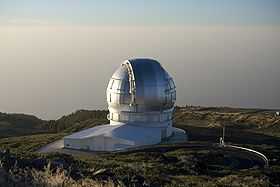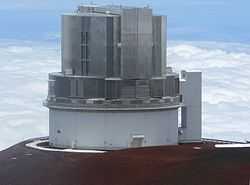List of largest optical reflecting telescopes
| The world's largest optical reflecting telescopes with an aperture diameter of larger than 8 meters (hover with mouse over image)
Legend: |
This list of the largest optical reflecting telescopes with objective diameters of 3.0 metres (120 in) or greater is sorted by aperture, which is one limit on the light-gathering power and resolution of a reflecting telescope's optical assembly. The mirrors themselves can be larger than the aperture, and telescopes may use aperture synthesis achieved by interferometry. Telescopes designed to be used as optical astronomical interferometers such as the Keck I and II used together as the Keck Interferometer (up to 85 m) can reach very high resolutions, although at a narrower range of observations. When the two mirrors are on one mount, the combined mirror spacing of the Large Binocular Telescope (22.8 m) allows fuller use of the aperture synthesis.
Largest does not always equate to being the best telescopes, and overall light gathering power of the optical system can be a poor measure of a telescope's performance. Space-based telescopes, such as the Hubble Space Telescope, take advantage of being above the Earth's atmosphere to reach higher resolution and greater light gathering through longer exposure time. Location in the northern or southern hemisphere of the Earth can also limit what part of the sky can be observed.
Table of reflecting telescopes
This list is ordered by optical aperture, which has historically been a useful gauge of limiting resolution, optical area, physical size, and cost. Multiple mirror telescopes that are on the same mount, may have a working beam combiner, and can form an image may be ranked by an equivalent aperture to this reported by sources. HET-style or fixed telescopes are ranked by an equivalent aperture also.
| Name | Image | Effective aperture m | Aper. in | Mirror type | Nationality / Sponsors | Site | Built |
|---|---|---|---|---|---|---|---|
| Gran Telescopio Canarias (GTC) | | 10.4 m | 409″ | Segmented, 36 | Spain (90%), Mexico, USA | Roque de los Muchachos Obs., Canary Islands, Spain | 2006/9 |
| Keck 1 | | 10 m | 394″ | Segmented, 36 | USA | Mauna Kea Observatories, Hawaii, USA | 1993 |
| Keck 2 | | 10 m | 394″ | Segmented, 36 | USA | Mauna Kea Observatories, Hawaii, USA | 1996 |
| Southern African Large Telescope (SALT) 11 m × 9.8 m mirror[1] | | 9.2 m | 362″ | Segmented, 91 | South Africa, USA, UK, Germany, Poland, New Zealand | South African Astronomical Obs., Northern Cape, South Africa | 2005 |
| Hobby-Eberly Telescope (HET) 11 m × 9.8 m mirror | | 9.2 m | 362″ | Segmented, 91 | USA, Germany | McDonald Observatory, Texas, USA | 1997 |
| Large Binocular Telescope (LBT) Phased-array optics for combined 11.9 m[2] | | 8.4 m × 2 | 330″ × 2 | Multiple mirror, 2 | USA, Italy, Germany | Mount Graham Internationals Obs., Arizona, USA | 2004 |
| Subaru (JNLT) | | 8.2 m | 323″ | Single | Japan | Mauna Kea Observatories, Hawaii, USA | 1999 |
| VLT UT1 – Antu | | 8.2 m | 323″ | Single | ESO Countries, Chile | Paranal Observatory, Antofagasta Region, Chile | 1998 |
| VLT UT2 – Kueyen | | 8.2 m | 323″ | Single | ESO Countries, Chile | Paranal Observatory, Antofagasta Region, Chile | 1999 |
| VLT UT3 – Melipal | | 8.2 m | 323″ | Single | ESO Countries, Chile | Paranal Observatory, Antofagasta Region, Chile | 2000 |
| VLT UT4 – Yepun | | 8.2 m | 323″ | Single | ESO Countries, Chile | Paranal Observatory, Antofagasta Region, Chile | 2001 |
| Gemini North (Gillett) | | 8.1 m | 318″ | Single | USA, UK, Canada, Chile, Australia, Argentina, Brazil | Mauna Kea Observatories, Hawaii, USA | 1999 |
| Gemini South | | 8.1 m | 318″ | Single | USA, UK, Canada, Chile, Australia, Argentina, Brazil | Cerro Pachón (CTIO), Coquimbo Region, Chile | 2001 |
| MMT (1 x 6.5 m) |  | 6.5 m | 256″ | Single | USA | F. L. Whipple Obs., Arizona, USA | 2000 |
| Magellan 1 (Walter Baade)[3] | | 6.5 m | 256″ | Honeycomb | USA | Las Campanas Obs., Coquimbo Region, Chile | 2000 |
| Magellan 2 (Landon Clay) | | 6.5 m | 256″ | Honeycomb | USA | Las Campanas Obs., Coquimbo Region, Chile | 2002 |
| BTA-6 | 6 m | 238″ | Single | USSR/Russia | Special Astrophysical Obs., Karachay–Cherkessia, Russia | 1975 | |
| Large Zenith Telescope (LZT) | 6 m | 236″ | Liquid | Canada, France, USA [4] | Maple Ridge, British Columbia, Canada | 2003 | |
| Hale Telescope (200 inch) | | 5.08 m | 200″ | Single | USA | Palomar Observatory, California, USA | 1948 |
| LAMOST (6.67 m × 6.05 m + 5.72 m × 4.40 m corrector; effective aperture 3.6–4.9 m) | | 4.9 m–3.6 m[5] | 193″ | Segmented (37 + 24)[6] | PRC (China) | Beijing Astronomical Obs., Xinglong, China | 2008 |
| MMT (original optics: 6 × 1.8 m) →see above record for current 6.5 m mirror |  | 4.7 m (6×1.8 m) [7] | 186″ | Segmented, 6 | USA | F. L. Whipple Obs., Arizona, USA | 1979–1998 |
| Discovery Channel Telescope[8] | | 4.3 m | 169″ | Single | USA | Lowell Observatory, Happy Jack, Arizona, USA | 2012 |
| William Herschel Telescope | | 4.2 m | 165″ | Single | UK, Netherlands, Spain | Roque de los Muchachos Obs., Canary Islands, Spain | 1987 |
| SOAR | 4.1 m | 161″ | Single | USA, Brazil | Cerro Pachón (CTIO), Coquimbo Region, Chile | 2002 | |
| VISTA | | 4.1 m | 161″ | Single | ESO Countries, Chile | Paranal Observatory, Antofagasta Region, Chile | 2009 |
| Victor M. Blanco Telescope |  | 4 m | 157″ | Single | USA | Cerro Tololo Inter-American Obs., Coquimbo Region, Chile | 1976 |
| Nicholas U. Mayall 4 m[9] | | 4 m | 149.5″ | Single | USA | Kitt Peak National Obs., Arizona, USA | 1973 |
| Anglo-Australian Telescope (AAT) | | 3.89 m | 154″ | Single | Australia, UK | Australian Astronomical Obs., New South Wales, Australia | 1975 |
| 3.67 m AEOS Telescope (AEOS) |  | 3.67 m | 145″ | Single | USA | Air Force Maui Optical Station, Hawaii, USA | 1996 |
| Telescopio Nazionale Galileo (TNG) | | 3.58 m | 138″ | Single | Italy | Roque de los Muchachos Obs., Canary Islands, Spain | 1997 |
| New Technology Telescope (NTT) | | 3.58 m | 142″ | Single | ESO countries | La Silla Observatory, Coquimbo Region, Chile | 1989 |
| Canada-France-Hawaii Telescope (CFHT) | | 3.58 m | 141″ | Single | Canada, France, USA | Mauna Kea Observatories, Hawaii, USA | 1979 |
| ESO 3.6 m Telescope | 3.57 m | 140″ | Single | ESO countries | La Silla Observatory, Coquimbo Region, Chile | 1977 | |
| MPI-CAHA 3.5 m[10] | | 3.5 m | 138″ | Single | West Germany, Spain | Calar Alto Obs., Almería, Spain | 1984 |
| USAF Starfire 3.5 m [11] |  | 3.5 m | 138″ | Single | USA | Starfire Optical Range, New Mexico, USA | 1994 |
| WIYN Telescope | | 3.5 m | 138″ | Single | USA | Kitt Peak National Obs., Arizona, USA | 1994 |
| Space Surveillance Telescope | | 3.5 m | 138″ | Single | USA | White Sands Missile Range, New Mexico, USA | 2011 |
| Astrophysical Research Consortium (ARC) | 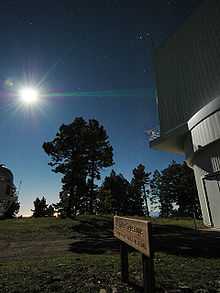 | 3.48 m | 137″ | Single | USA | Apache Point Obs., New Mexico, USA | 1994 |
| Shane Telescope | | 3.05 m | 120″ | Single | USA | Lick Observatory, California, USA | 1959 |
| NASA Infrared Telescope Facility | | 3.0 m | 120″ | Single | USA | Mauna Kea Observatory, Hawaii, USA | 1979 |
| NASA-LMT →retired, private[12] | 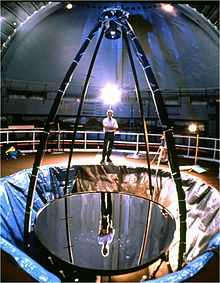 | 3 m | 118″ | Liquid | USA | NASA Orbital Debris Obs., New Mexico, USA | 1995–2002 |
| See List of large optical reflecting telescopes for continuation of list | |||||||
There are only a few sites capable of polishing the mirrors for these telescopes. SAGEM in France polished the four VLT mirrors, the two Gemini mirrors, and the 36 segments for GTC.[13] The Steward Observatory Mirror Lab cast and polished the two LBT mirrors, the two Magellan mirrors and the MMT replacement mirror. It is currently making the LSST primary mirror and the mirrors for the Giant Magellan Telescope.[14] The Keck segments were made by Schott AG. The SALT and LAMOST segments were cast and polished by LZOS.[15] The mirror for Subaru was cast by Corning and polished at Contraves Brashear Systems in Pennsylvania.[16]
This table does not include all the largest mirrors manufactured. The Steward Observatory Mirror Lab produced the 6.5-metre f/1.25 collimator used in the Large Optical Test and Integration Site of Lockheed Martin, used for vacuum optical testing of other telescopes.
Segmented mirrors are also referred to as mosaic mirrors. Single mirrors are also referred to monolithic mirrors, and can be sub-categorized in types, such as solid or honeycomb.
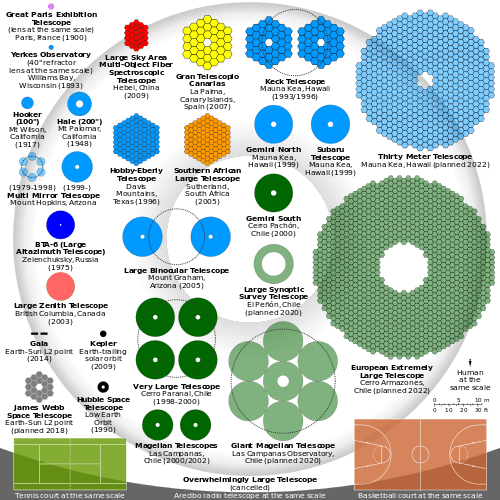

Top telescopes of 2010
The largest telescopes are multi-telescope interferometers, and may have longer baselines. However, these astronomical interferometers are less flexible in use, and many interferometers cannot form images or see faint objects despite their high peak angular resolution.
The largest telescope during the first decade of the 21st century could be either the Gran Telescopio Canarias (one 10.4 m diameter mirror), the Large Binocular Telescope (two 8.4 m diameter mirrors on a binocular mount), or the Very Large Telescope (with four 8.2 m telescopes and four 1.8 m auxiliary telescopes). However, as these were still coming online in the period, the two 10 m Keck Telescopes (with 85 m aperture synthesis) were possibly the largest in full scientific operation.
Note other wavelengths of telescopes can be much larger physically, such as the 305 m aperture Arecibo radio telescope, but since radio wavelengths are also larger, this does not necessarily translate into brighter or higher resolution images.
| Name | Out | In | Aperture (m) | Equiv. Area (m) | Area (m2) | Mirrors | Note | Altitude (m) |
|---|---|---|---|---|---|---|---|---|
| Gran Telescopio Canarias (GTC) | | | 10.4 | 10.4 | 74 | 36 × 1.9 m hexagonal segments for M1 | Commissioned 2009; Largest single mirror | 2267 |
| Southern African Large Telescope (SALT) | |  | 11 (max.) | 9.2 | 66–45 | 92 × 1 m hexagon; 11 × 9.8 m mirror | HET twin but larger optically. Spherical M1 w/ fixed mirror; spectroscopy (see here ) | 1783 |
| Keck 1 & 2 | | | 10 m each | 10 | 76 (each)[17] | 36 × 1.8 m hexagons M1 mirrors each | largest twin telescopes 152 m2 total optical area | 4145 |
| VLT 1, 2, 3 & 4 | | | 8.2 (each) | 8.2 | 53 (each) | 1 x 8.2 m M1 each | Largest quadruplet telescope 210 (total optical area) | 2635 |
| Large Binocular Telescope (LBT) | | | 8.4 m each | 11.7 | 111 (both sides) | 2 x 8.4 m M1 mirrors; 1 mount | Largest Binocular; largest non-segmented mirrors; 22.8 m aperture planned [18] | 3221 |
Largest telescopes with interferometer mode, and two image-forming interferometer arrays.
| Name | Longest baseline (m) | Mirrors | Area (m2) | Equiv. | Note |
|---|---|---|---|---|---|
| VLTI | 200 | 4 × 8.2 m (VLT 1,2,3, & 4) | 210 [19] | 16 | Behind schedule in 2010, 4 units at 130 m success in 2012[20] |
| Keck Interferometer | 85 | 2 × 10 m (Keck 1 & 2) | 152[19] | Operations ceased in 2012.[21] | |
| Large Binocular Telescope (LBTI) | 22.8* | 2 × 8.4 m | 110 [19] | 11.9 | One telescope mount*; Fizeau & Amplitude Interferometry |
| CHARA array | 330 | 6 × 1 m | 2.45 [22] | ||
| NPOI | 437 | 6 siderostats (visible) | Sparse Aperture [19] | Optically resolved Mizar (star) |
*Baseline does not reduce with viewing angle
Top telescopes of 2000
| Name | Out | In | Aperture (m) | Area (m2) | Mirrors | Note | Altitude (m) |
|---|---|---|---|---|---|---|---|
| Keck 1 & 2 | | | 10 (each) | 76 (each)[17] | 36 × 1.8 m hexagons M1 mirrors each | largest twin telescopes, largest aperture mirrors, 152 m2 total optical area | 4145 |
| Hobby-Eberly Telescope (HET) | |  | 9.2 (max.) | 66–45 | 92 x 1 m hexagon; 11 × 9.8 m mirror | Spherical M1 w/ fixed mirror; spectroscopy | 2030 |
| Subaru Telescope | |  | 8.2 | 53 | 1 × 8.3 m M1 | Largest single piece mirror (tied with the 4 VLT) | 4145 |
| VLT 1, 2, 3 & 4 | | | 8.2 (each) | 53 (each) | 1 x 8.2 m M1 | Largest quadruplet telescope; largest single piece mirrors (tied with Subaru) | 2635 |
Chronologically
| Years Largest | Name | Out | In | Aperture (m) | Area (m2) | M1 Mirror | Note | Altitude (m) |
|---|---|---|---|---|---|---|---|---|
| 2009–Present | Gran Telescopio Canarias | |  | 10.4 | 74 | 36 × 1.9 m hexagons M1 mirror | Segmented mirror | 2267 |
| 1993–2009 | Keck 1 | | | 10 | 76 [17] | 36 × 1.8 m hexagons M1 mirror | Segmented mirror, M1 f/1.75 | 4145 |
| 1976–1993 | BTA-6 | | | 6 | 26 | 605 cm f/4 M1 mirror | Mirror replaced twice | 2070 |
| 1948–1976 | Hale (200 inch) | | | 5.1 | – | 508 cm f/3.3 M1 mirror | Art deco dome | 1713 |
| 1917–1948 | Hooker (100 inch) | | 2.54 | – | Also used for 1st optical interferometer | 1742 |
For earlier top telescopes see List of largest optical telescopes historically
Plans
Below are selected telescopes that are still in the conceptual/proposed stage or still under construction.


- Under construction or planned construction
- European Extremely Large Telescope 39.3 m (first light planned for 2024)[23]
- Thirty Meter Telescope 30 m[24]
- Giant Magellan Telescope 7 × 8.4 m mirrors (24.5 m aperture; 21.4 m equivalent area)[25]
- Large Synoptic Survey Telescope 8.4 m (development approved as of 2012 for 2021 first light)
- James Webb Space Telescope 6.5 m (2018 launch planned)
- Pan-STARRS 4 × 1.8 m (1 of 4 complete)
- Magdalena Ridge Observatory Telescope Array 10 × 1.4 m
- Advanced Technology Solar Telescope 4 m (see also list of solar telescopes)
- International Liquid Mirror Telescope 4 m[26]
- 3.6 m Devasthal Optical Telescope [27] (Indo-Belgian telescope)
- San Pedro Martir Telescope 6.5 m[28]
- Planned
- Advanced Technology Large-Aperture Space Telescope (ATLAST), 8–15 m space telescope
- Chinese Giant Solar Telescope (CGST). China aims to build a very large infrared and optical solar telescope, with the spatial resolution expected to be equivalent to an 8-meter-diameter telescope and light-gathering power equivalent to a 5 m diameter full aperture telescope [29][30]
- The Colossus Telescope.[31]
See also
- Extremely large telescope
- List of largest optical refracting telescopes
- List of optical telescopes
- List of astronomical interferometers at visible and infrared wavelengths
- List of largest optical telescopes historically
- List of largest optical telescopes in the 20th century
- List of largest optical telescopes in the 19th century
- List of largest optical telescopes in the 18th century
- Strehl ratio
References
- ↑ "Howstuffworks "10 Amazing Telescopes"". Science.howstuffworks.com. Retrieved August 19, 2009.
- ↑ SPIE 2006 in Orlando - Proceedings of SPIE conference 6267 on “Ground-based and Airborne Telescopes”, "The Large Binocular Telescope", John M. Hill, Richard F. Green and James H. Slagle
- ↑ "The Carnegie Observatories – Magellan Telescopes". Ociw.edu. Retrieved August 19, 2009.
- ↑ The Telescope, By Geoff Andersen, Page 165
- ↑
- ↑ "LAMOST Homepage – Gallery". Lamost.org. June 22, 2008. Retrieved August 19, 2009.
- ↑ Dwayne DayMonday, May 11, 2009 (2009-05-11). "Mirrors in the dark". The Space Review. Retrieved 2012-01-03.
- ↑ Lowell Observatory - DCT status
- ↑ "The Mayall 4-Meter Telescope". Noao.edu. February 27, 1973. Retrieved August 19, 2009.
- ↑ "Max-Planck-Institut für Astronomie". Mpia.de. July 20, 1994. Retrieved August 19, 2009.
- ↑ John Pike. "Starfire". Globalsecurity.org. Retrieved August 19, 2009.
- ↑ "NASA Orbital Debris Observatory". Astro.ubc.ca. Retrieved August 19, 2009.
- ↑ "Polissage Optique pour les Grands Instruments de la Physique et de l ’Astronomie" (PDF).
- ↑ "Mirror Castings". Steward Observatory Mirror Lab.
- ↑ "Large Optics Manufacturing in Large Optics Manufacturing in Lytkarino Optical Glass Factory, Russia" (PDF).
- ↑ "SUBARU Telescope 8.3m Primary Mirror Finished".
- ↑ 17.0 17.1 17.2 "Keck Telescope Facts". Spacecraftkits.com. Retrieved 2012-01-03.
- ↑ http://lbti.as.arizona.edu/LBTI-Main/Project.html
- ↑ 19.0 19.1 19.2 19.3 "Telescope - Modern Optical Telescopes - Mirror, Diameter, Keck, and Honeycomb - JRank Articles". Science.jrank.org. Retrieved 2012-01-03.
- ↑ K. Moskvitch - Four telescope link-up creates world's largest mirror (2012) - BBC
- ↑ KI
- ↑ "Large Telescopes". Astro.nineplanets.org. Retrieved 2012-01-03.
- ↑ "Groundbreaking for the E-ELT (eso1419 — Organisation Release)". ESO. 19 June 2014. Retrieved 3 January 2015.
- ↑ "Thirty Meter Telescope". Tmt.org. Retrieved August 19, 2009.
- ↑ "GMT – Technical Overview". Gmto.org. Retrieved August 19, 2009.
- ↑ "International Liquid Mirror Telescope – Extragalactic Astrophysics and Space Observations". Aeos.ulg.ac.be. Retrieved August 19, 2009.
- ↑ 3.6 m Devasthal Optical Telescope
- ↑ CAPI Report (in Spanish). Nov. 4,2013
- ↑ "Introduction to the Chinese Giant Solar Telescope" (PDF).
- ↑ Staff (29 August 2012). "China Exclusive: Scientists looking for site for giant solar telescope". Retrieved 8 December 2014.
- ↑ The Colossus
Further reading
- "The Astronomical Scrapbook", Joseph Ashbrook, Sky Publishing Corporation 1984, ISBN 0-933346-24-7, o
- "Giant Telescopes of the World", Sky and Telescope, August 2000.
- "The History of the Telescope", Henry C. King. (1955)
- "The Historical Growth of Telescope Aperture", René Racine, Publications of the Astronomical Society of the Pacific, 116
- JRASC (1929) vol 23, p351
- Sky&Telescope (April 1981) p303
- Sky&Telescope (July 1993) vol 86, p 27-32
- James H. Burge, 1993 Dissertation at UA, "Advanced Techniques for Measuring Primary Mirrors for Astronomical Telescopes"
- Bell, R.M. and Robins, G.C. and Eugeni, C. and Cuzner, G. and Hutchison, S.B. and Baily, S.H. and Ceurden, B. and Hagen, J. and Kenagy, K. and Martin, H.M. and Tuell, M. and Ward, M. and West, S.C. (July 2008). "LOTIS at completion of Collimator integration". Society of Photo-Optical Instrumentation Engineers (SPIE) Conference Series 7017. doi:10.1117/12.791889.
